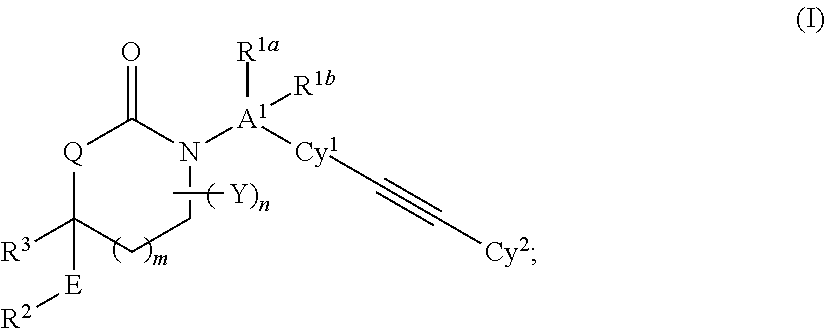Cyclic Inhibitors of 11 beta-Hydroxysteroid Dehydrogenase 1
a technology of hydroxysteroid dehydrogenase and cyclic inhibitors, which is applied in the direction of biocide, drug composition, metabolic disorders, etc., can solve the problems of impaired wound healing, loss of partial visual field and eventually blindness, and adverse effects on skeletal tissues
- Summary
- Abstract
- Description
- Claims
- Application Information
AI Technical Summary
Benefits of technology
Problems solved by technology
Method used
Image
Examples
preparation 1
3-(2-methylbut-3-yn-2-yl)oxazolidin-2-one
[0282]
Step 1
[0283]A stirred solution of 1,1-dimethylpropargylamine (521 mg, 6.3 mmol) in MeCN (25 mL) was cooled in an ice bath and powdered K2CO3 (1.91 g, 13.8 mmol) was added. A solution of 2-chloroethyl chloroformate (0.68 mL, 6.6 mmol) in MeCN (10 mL) was added dropwise over 5 min. The cooling bath was allowed to melt and the mixture was stirred overnight at rt and then refluxed for 8 h. The mixture was concentrated and the residue was dissolved in EtOAc (100 mL), washed with water (15 mL) and brine (15 mL), and dried over Na2SO4. Removal of the solvent left crude 2-chloroethyl 2-methylbut-3-yn-2-ylcarbamate (1.05 g, 88%).
Step 2
[0284]Crude 2-chloroethyl 2-methylbut-3-yn-2-ylcarbamate (1.05 g, 5.5 mmol) was dissolved in dry THF (20 mL) and 60% NaH in oil (665 mg, 16.6 mmol) was added. The mixture was stirred under N2 for 1 day and 5% aq HCl (25 mL) was added. The mixture was extracted with EtOAc (175 mL). The organic layer was washed with ...
preparation 2
Butyl 2,2-dimethylbut-3-ynoate
[0285]
[0286]The title compound was prepared following the procedure described in Just, Z. W.; Larock, R. C. J. Org. Chem. 2008, 73, 2662-2667.
preparation 3
1-(azetidin-1-yl)-2,2-dimethylbut-3-yn-1-one
[0287]
[0288]To a stirred solution of 1,1-dimethyl-3-butynoic acid (333 mg, 3.0 mmol), azetidine (250 mg, 4.5 mmol) and i-Pr2NEt (1.6 mL, 8.9 mmol) in CH2Cl2 (20 mL) was added solid HATU (1.25 g, 3.3 mmol). The mixture was stirred at rt for 20 h and concentrated to leave a yellow oil. This oil was taken up in EtOAc (100 mL), washed with 5% aq HCl (2×15 mL), satd aq NaHCO3 (15 mL) and brine (15 mL), and dried over Na2SO4. Removal of the solvent left an oil (819 mg) which was purified by chromatography on a 12-g silica cartridge, eluted with a 0-100% EtOAc in hexanes gradient, to afford 1-(azetidin-1-yl)-2,2-dimethylbut-3-yn-1-one (198 mg, 44%) as an oil. 1H NMR (CDCl3) 1.40 (s, 6H), 2.23 (m, 2H), 2.34 (s, 1H), 4.05 (m, 2H), 4.52 (m, 2H).
PUM
| Property | Measurement | Unit |
|---|---|---|
| temperature | aaaaa | aaaaa |
| temperature | aaaaa | aaaaa |
| temperature | aaaaa | aaaaa |
Abstract
Description
Claims
Application Information
 Login to View More
Login to View More - R&D
- Intellectual Property
- Life Sciences
- Materials
- Tech Scout
- Unparalleled Data Quality
- Higher Quality Content
- 60% Fewer Hallucinations
Browse by: Latest US Patents, China's latest patents, Technical Efficacy Thesaurus, Application Domain, Technology Topic, Popular Technical Reports.
© 2025 PatSnap. All rights reserved.Legal|Privacy policy|Modern Slavery Act Transparency Statement|Sitemap|About US| Contact US: help@patsnap.com



